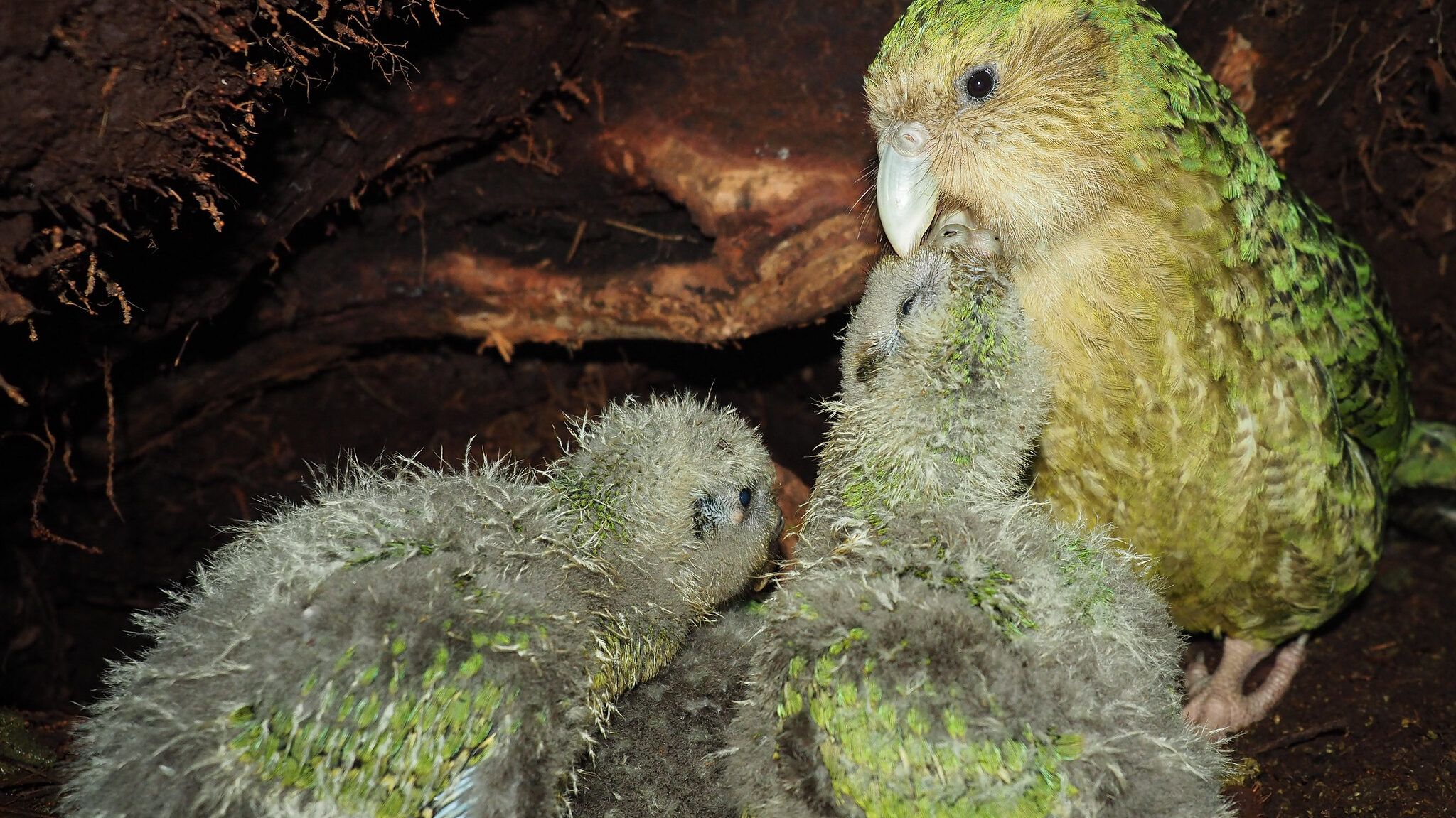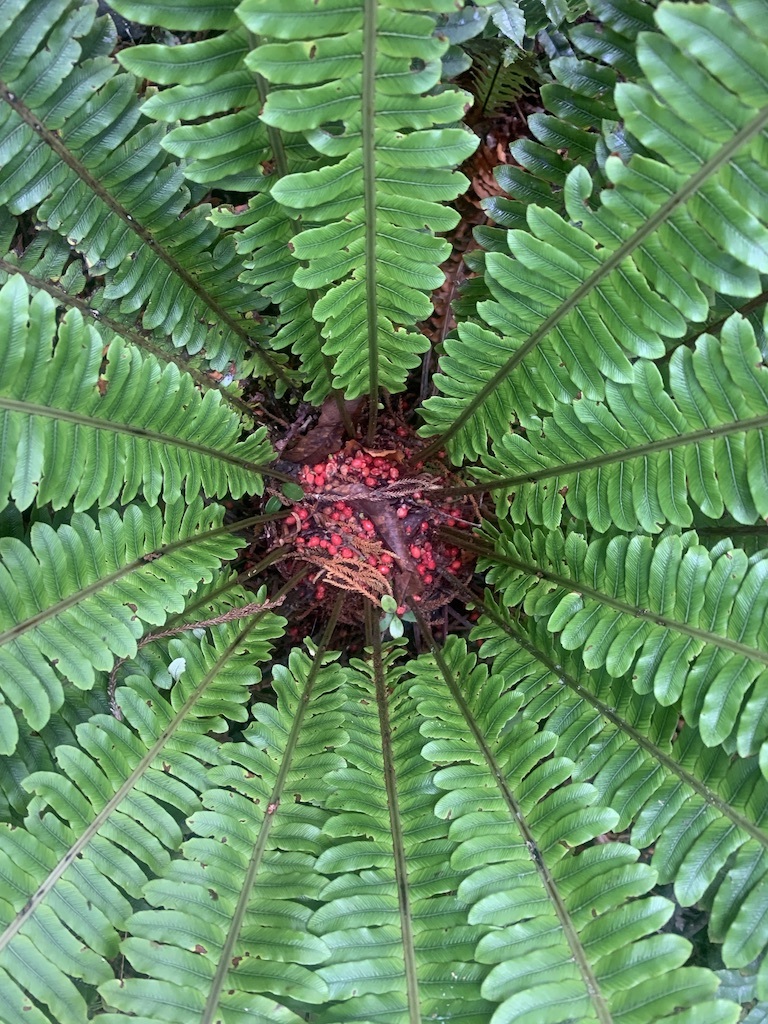Cupid’s bow and arrow have well and truly hit their mark this kākāpō breeding season. We’ve seen mammoth mating sessions, super-sized clutches, and reclusive bachelors getting back in the game.

This Valentine’s day, we take a look at one of the most successful kākāpō breeding seasons to date – and what it means for this much-loved, critically endangered bird.
Tracking toward one of the best seasons on record
With only 201 individuals left in existence, every breeding season is crucial for the critically endangered kākāpō.
Currently, we’re sitting close to the middle of kākāpō breeding season. Mating is more or less done and dusted. Most eggs have been laid. Mothers are busy incubating their (sometimes fake) eggs. And the first fuzzy chicks have hatched.
As of Valentine’s day 2022, 131 eggs have been laid (that are known), 67 have been confirmed as fertile, and 12 chicks have hatched. Proverbially speaking, it’s never good practice to count your kākāpō before they hatch. But all going well, we could be looking at somewhere between 30-50 new fledglings this season.
How does this compare to previous years? 2019 is a hard year to top – and stands as the most successful breeding season on record, resulting in 71 fledglings.
We’re unlikely to see numbers this high in the current season, because in 2019 many of the mothers were allowed to lay a second time. This season, precautions around COVID-19 have mostly ruled this approach out.
So the outcomes of this year are without a doubt a big step in the right direction for the survival of the species.
A weird, wacky wonderful season
Described as “the world’s weirdest birds” by Department of Conservation (DOC) Kākāpō Recovery Science Advisor Dr Andrew Digby, kākāpō are birds that constantly surprise and delight with their unusual behaviours.
And this season has been no exception.
The programme’s known-oldest female bird, Nora, has been giving it her all to ensure the species survival. This year she has outdone herself with her dedication, mating with two males in one night – for an impressive total time of over 90 minutes.
“She would probably be quite tired after all that,” says DOC Ranger Bronwyn Jeynes. “She’s an absolutely delightful bird, an incredible incubator and amazing mum. She’s super into it.”
Looking to the boys, Ralph is a returnee to the kākāpō dating scene. Described by Andrew as “a shy fellow”, before this season, Ralph hadn’t mated since 1999!
On the other end of the spectrum, there have been some very successful males. Kōmaru bred for the first time in 2019 and produced an incredible 10 chicks that season. This year he’s mated with eight different females – making him now one of the most sought after males on his island.
Kōmaru might become a victim of his own success, with talk of shipping him off to another island – to let some other males have a better chance and keep the population genetically diverse.
Another pleasant surprise for the year has been some very large clutch sizes. A standard clutch is two to three eggs. Andrew reports that this year the team have seen several clutches with four eggs. And kākāpō Yasmine even delighted the team with a clutch of five eggs (although these were infertile).
More birds and a more diverse gene pool
Perhaps the biggest excitement of the year is the spread of important genes through the population.
Andrew says this all comes down to a now deceased bird called Richard Henry.
“Richard Henry is a bird of particular significance for the kākāpō,” says Andrew. “He was the last surviving Fiordland bird. His very unique DNA has been crucial in ensuring genetic diversity among the population.
“This year we’ve got more birds that are descendants from Richard Henry at breeding age than we’ve ever had before.”
This season three females have chosen to mate with Gulliver, whose father was Richard Henry.
This is pretty promising news, as Bronwyn explains it, “Gulliver has some unique genes for disease resistance that we really want to continue in the population.
“So it’s really exciting to see him mating. He’s 23, and this is only the second time we’ve seen him involved in a breeding season,” she says.
While it might seem that Gulliver is a late bloomer, kākāpō are believed to live up around 60-80 years. Males don’t start breeding till around age seven, so there’s still plenty of time for Gulliver to pass his genes along.
Reasons for the successful season
They key to this year’s success? We can’t give cupid all the credit, there are a number of hard working people that have made this season a success.
The team involved includes DOC rangers and volunteers, financial backers and scientists and researchers working on new tech for the team.
Aside from the people, positive environmental factors have also played a big hand in creating such a successful season.
Kākāpō don’t breed every year. Their breeding seasons are dependent on mast years.
Masting is a phenomenon where all the plants of one species produce lots of fruit at the same time. Masting tree species often don’t produce fruit every year, instead fruiting in vast quantities every 2-6 years.
Kākāpō’s breeding food source in southern New Zealand is the rimu tree – and this season rimu seed counts have been very high.
“We’ve had a huge rimu mast this season. It’s been at levels that would support almost every female to breed,” says Bronwyn.
In a poor breeding season, where environmental conditions and food supply aren’t optimal, birds may decide not to mate or take part in the breeding season. So with such an ample supply of food, no surprise that this year our beloved birds decided to make hay – and many eggs – while the sun’s been shining.

What’s next for the kākāpō?
As the breeding programme goes from success to success, a new challenge has presented itself: finding enough suitable habitat for a growing kākāpō population.
Currently birds are largely scattered across two predator-free islands: Pukenui (Anchor Island) and Whenua Hou (Codfish Island). Thanks to digital tracking and bird behaviour, DOC can see the birds are essentially at their capacity on these two islands.
The need for more space has led the team to start a new breeding kākāpō population on Te Kākahu O Tamatea (Chalky Island). This is the first year the programme has had birds nesting and mating on the island. However, as the population grows we will need more good-quality environments.
Bronwyn says, “Because we’re working on predator free islands, all we have to focus on is the breeding. Whereas on the mainland, you have to start worrying about rats, stoats and possums. It’s simply too hard for the birds to go up against these introduced predators.”
Setting sights on Rakiura
“I feel the ultimate dream for the programme would be to return birds to Rakiura (Stewart Island). Because the majority of our founder birds came from there, we know the habitat is suitable and that they can breed there without our support,” says Bronwyn.
“But it would take a lot of work to get to that point – currently feral cats are the biggest issue on Rakiura. I believe the original studies on the kākāpō population there saw some 50 percent of tracked adult birds eaten by cats.
“Rats, possums and hedgehogs are also issues on the island, as they prey on eggs and small chicks. If we could get to the point of a predator free Rakiura, it would really help ensure the survival of the species.
“In the meantime, we are looking at other predator free or low-predator islands or mainland sites. But these are all limited in size so they’re only short-term options. The only real long-term solution is having large predator free spaces.
“Kākāpō are wild, but their survival is closely managed to maintain the species. We can’t do this forever.
“The Predator Free 2050 goal itself really is the biggest hope we have for the continuation of the kākāpō,” says Bronwyn.
Want to help the world’s weirdest bird?
Here are our top 3 ways you can support the kākāpō:
- Help work toward a Predator Free 2050 by backyard trapping or joining your local predator free community group
- Spread the world – tell your network about the importance of the predator free movement, and how it’s helping to save our beloved bird

